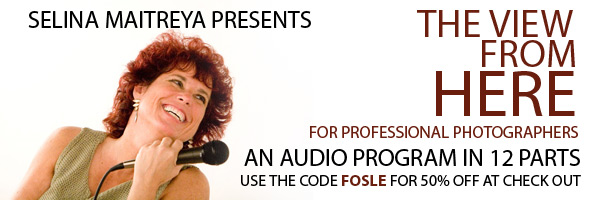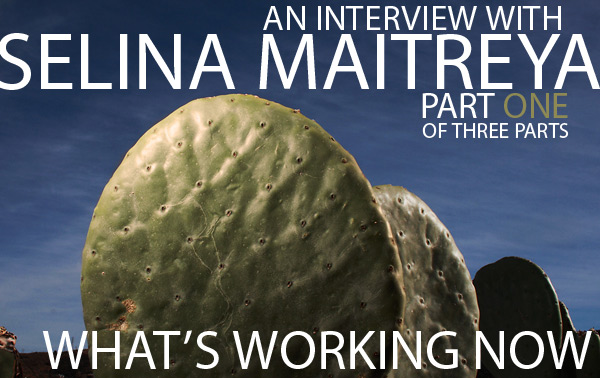We present a three part look at the current business of commercial and editorial photography through the ‘lens’ of Selina Maitreya, photographers coach and consultant. Selina’s 30+ years experience working with photographers all over the globe has given her a unique and deep understanding of what it takes to compete in a crowded market.
First things first: Selina’s website is 1PortAuthority.com, and it is there you can read about what she does for photographers. You can also download a free chapter of her amazing audio series “The View From Here” and purchase her newest book “How To Succeed In Commercial Photography: Insights From A Leading Consultant.” If you do purchase the audio series, be sure to enter the code FOSLE to get $100 off (50%) the purchase price.
We began the interview with the question that so many photographers are asking:
What’s Working Now:
“Vison. Style… and great photography of course. The ability to create a solid body of work and get that body of work into the website, portfolio and portals that are so necessary for getting in front of the people who are buying the work. It isn’t enough to just have great pictures, they have to relate to each other through the personal vision of the photographer.
It has to be what I call a “body of work”, not just good pictures assembled in a portfolio, They have to be connected by the vision, the style, the eye of the photographer. Tell a story through a single image or multiple images… images that can tell a story are very powerful.
Finding that vision is the hardest part, but so is putting it together in a cohesive presentation. The basics haven’t changed… you must create wonderful pictures. That will never change, but that isn’t enough. The pictures must show something more… a vision that is unique, or at least unique enough to interest a buyer into calling your book in.
Passion.
What are you passionate about? That passion should be so much a part of what you do. Get passionate about what you want to do and your vision and your work. Develop that personal vision to get the photography you feel best depicts what you do and who you are.”
This is somewhat a more difficult thing to do for photographers in smaller markets. Creating a magnificent portfolio with few to show it is making some photographers think about making huge, career shifting decisions.
“I have always believed that photographers should market regionally. Take two hours from your home town and draw a circle. That’s your target now. You must market to that region and not just focus on your own backyard. Narrow your scope to the buyers that make sense to what you do and get in front of as many people as you can.
Even smaller 2nd and 3rd tier cities are being marketed to by European and other foreign shooters these days. Getting your work in front of people in cities within a couple hours of you is one way to make your reach wider. This is especially true for advertising photographers where there is a lot of challenges now.”
I live in Phoenix, so two hours north, east, west all have nothing, and south of me is Tucson… a much smaller market than Phoenix is. I can only imagine what shooters in Vegas are thinking at this moment…
“Then widen the circle to at least a couple of cities as close to you as possible. And find the people who are interested in your work.
Identifying who would be a possible client is sometimes hard, but find at least four channels that make sense for the kind of work that you do. Industrial, design, lifestyle and portrait for instance… then find the clients who use that kind of work and get your work in front of them. The same basics that have always worked are working today… but there are other forms of marketing today… websites, email and portfolio showings are all important. Finding the buyers who are looking for photographers with vision and style is more important than ever.”
Marketing nationally is as important. Don’t let the geography get in your way. Local, regional and nationally it is important to get the website into as many channels of presentation as possible. You want buyers to find you by reading your blog post, then seeing your portfolio, then a personal phone call. Get your site listed on portals where buyers visit and attract them that way. Interacting on social media can mean a potential client sees your FaceBook Fan page, and checks your blog and then heads over to your web site. Mix it up and make as many entry points as possible.”
What do you think is happening with social media these days? Is it something that photographers should spend time with?
“Oh yes. It may not be what we all want it to be at all times, but it is here to stay. Getting involved now means not catching up later. I have a twitter account, but the blog thing has to wait. I am terribly busy right now and taking that on is not happening right now. You have to be committed, you know.”
I think that commitment is so important to the entire life of a photographer as well. I don’t think you can compete unless you are totally committed to it.
“It is really like having a child, you know. Total maintenance. You have to want it and love it and be so totally committed to your photography that nothing else can replace it. Photography is a wonderful business, you know, and I have known so many talented, committed and successful photographers. Even the struggling photographers keep on… they have to. It is in their blood.
I asked my first husband why he kept struggling at music (you think photography is a hard business… music is so hard and full of heartbreak). He said “I can’t not do it.” That is what I mean be commitment… you can’t not do this thing you love.”
Wrap up for part One:
- Create a portfolio (body of work) of images that shows a vision and a style. (More coming on this)
- Market regionally
- Find markets close to yours and identify clients that would be interested in your work
- Identify at least four types of buyers who would use your work
- Create multiple channels for the clients to find your work and you
- Be committed and passionate about your work
Thanks, Selina.
Part Two is here.
Part Three is here.
Follow me on Twitter, and visit my workshop site at Learn to Light.






